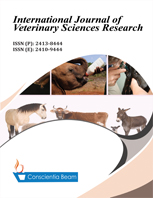Blood Picture and Selected Oxidative Stress Biomarkers in Dromedary Camels Naturally Infected with Trypanosoma Evansi
DOI:
https://doi.org/10.18488/journal.110/2015.1.2/110.2.46.53Abstract
Additional Biomarkers are required for estimation of the oxidative stress status in camel trypanosomiasis. Therefore, the present study aimed to determine lipid peroxidation, enzymatic antioxidants level and hematological indices in camels naturally infected with Trypanosoma evansi and trypanosome free camels (control). The clinical examinations reveled that all the infected camels showed signs of loss of appetite, diarrhea and loss of weight with poor body condition. Hematological analysis revealed a significant decrease (P=0.022-0.031) in the values of total erythrocytic count (TEC), hemoglobin (Hb) and Packed cell volume (PCV) in trypansoma infected camels (5.0 ± 0.5 ×1012/L; 5.7 ± 0.5 g/dl; 21.8 ± 1.0%) compared to control group (9.6 ± 0.6 ×1012/L; 10.3 ± 0.5 g/dl; 29.1 ± 1.5%). However, the values of total leucocytic counts (TLC) and differential counts were comparable to the control values except for Eosinophils value which were significantly (P=0.023) increased in trypanosome infected camel (6.0 ± 1.9%) compare to the control (1.8 ± 0.8%). Biochemical analysis indicated that, lipid peroxidation level was significantly (P=0.021) increased in trypansoma infected camels as reflected on higher values of malonaldhyde (MDA; 6.3 ± 0.3µM) as compare to the control (0.07 ± 0.01µM). The activity of glutathione reductase was significantly (P=0.025) increased in trypansoma infected camels (1.3 ± 0.01nmol/ml) compare to the control (0.8 ± 0.2nmol/ml) whereas, the activity of super oxide dismutase (SOD) remained unchanged (P=0.072) in trypansoma infected camels compare to the control healthy animal. The present findings concluded that Trypanosoma evansi infection in camels was associated with lipids peroxidation and oxidative stress. In addition, the present study suggests that glutathione reductase may use as oxidative stress biomarker in Trypanosoma evansi infection in camels.

